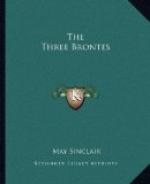[Footnote A: It was Miss Wooler who taught Charlotte to “peruse".]
For genius like theirs is destiny. And that brings us back to the eternal question of the Sources. “Experience” will not account for what was greatest in Charlotte. It will hardly account for what was least in Emily. With her only the secret, the innermost experience counted. If the sources of Wuthering Heights are in the “Gondal Poems”, the sources of the poems are in that experience, in the long life of her adventurous spirit. Her genius, like Henry Angora and Rosina and the rest of them, flew from the “Palaces of Instruction”. As she was Henry Angora, so she was Heathcliff and Catherine Earnshaw.
It is a case of “The Horse I rode at the battle of Zamorna”, that is all.
There has been too much talk about experience. What the critic, the impressionist, of the Brontes needs is to recover, before all things, the innocence of the eye. No doubt we all of us had it once, and can remember more or less what it was like. To those who have lost it I would say: Go back and read again Mrs. Gaskell’s Life of Charlotte Bronte.
Years and years ago, when I was a child, hunting forlornly in my father’s bookshelves, I came upon a small, shabby volume, bound in yellow linen. The title-page was adorned with one bad wood-cut that showed a grim, plain house standing obliquely to a churchyard packed with tombstones—tombstones upright and flat, and slanting at all angles. In the foreground was a haycock, where the grave grass had been mown. I do not know how the artist, whose resources were of the slenderest, contrived to get his overwhelming but fascinating effect of moorland solitude, of black-grey nakedness and abiding gloom. But he certainly got it and gave it. There was one other picture, representing a memorial tablet.
Tombstones always fascinated me in those days, because I was mortally afraid of them; and I opened that book and read it through.
I could not, in fact, put it down. For the first time I was in the grip of a reality more poignant than any that I had yet known, of a tragedy that I could hardly bear. I suppose I have read that book a score of times since then. There are pages in it that I shrink from approaching even now, because of the agony of realization they revive. The passing bell tolled continually in the prelude; it sounded at intervals throughout; it tolled again at the close. The refrain of “Here lie the Remains” haunted me like a dolorous song. It seemed to me a decorous and stately accompaniment to such a tale, and that wood-cut on the title-page a fitting ornament. I knew every corner of that house. I have an impression (it is probably a wrong one) of a flagged path going right down from the Parsonage door through another door and plunging among the tombs. I saw six little white and wistful faces looking out of an upper window; I saw six little children going up and up a lane, and I wondered how the tiny feet of babies ever got so far. I saw six little Bronte babies lost in the spaces of the illimitable moors. They went over rough stones and walls and mountain torrents; their absurd petticoats were blown upwards by the wind, and their feet were tangled in the heather. They struggled and struggled, and yet were in an ecstasy that I could well understand.




